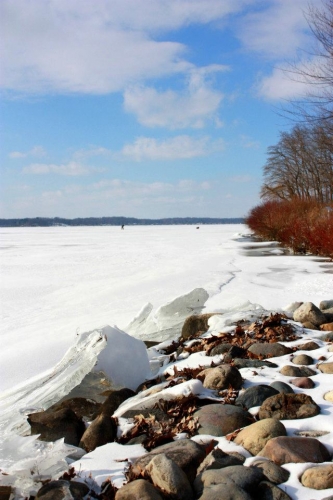Ice ridges on your property can create habitat and slow shoreline recession
While many lakefront homeowners are eager to remove ice ridges, there are many benefits to keeping them in place.
 Many Michigan lakefront properties experience ice action from one year to the next. Although different terms are used to describe ice action, it can be a result of one or both of the following phenomena:
Many Michigan lakefront properties experience ice action from one year to the next. Although different terms are used to describe ice action, it can be a result of one or both of the following phenomena:
- Ice push can occur during winters with little snow cover and lots of sunny days. The sun warms the ice, causing it to expand and crack. Melt water on the surface flows into the cracks and then refreezes at night, pushing the ice sheet outward toward the shore. Constant thawing and refreezing can cause the ice sheet to expand and grind away at the shore; undercutting and even uplifting soils to create a ridge on the shoreline.
- Spring break-up or ice-out is more noticeable, as the melting ice breaks into large chunks that are pushed to one side of the lake or another with shifting spring winds. Ice can pile up against the shoreline – pushing and uplifting soils to create an ice ridge.
Some lakefront properties experience ice damage from spring winds almost annually. Property owners might consider installing hard-scaped rock or sea walls to protect their shorelines. However, these hard-scaped methods can reduce or destroy sensitive shoreline and near-shore habitats important to the health of the lake. Learning to “live with” your ice ridge can be part of the natural approach to shoreline management.
Consider the shoreline of an undeveloped lake. It too is constantly being shaped and reshaped by the forces of wind, waves and ice. However, the combined root structures of natural shoreline vegetation (such as trees, shrubs and wetland aquatic plants) can resist ice action and minimize the formation of ice ridges. When natural shoreline vegetation is replaced with short-rooted turf grass to create lawns and view scapes, ice ridges can form more easily.
Lakefront property owners are sometimes eager to remove ice ridges; cutting, regrading and then reseeding the grass each year. But this practice can result in shoreline recession and the loss of valuable lakefront property as the ice pushes the soil back again the following year. Planting the ice ridge to native shrubs can stabilize the ice ridge and help it withstand future ice action.
Often, the concern with this approach is a blocked view of the lake. However, most native shrubs (e.g. Cornus sericea, Red-osier dogwood) may be pruned to a height that minimizes this problem. Lakefront property owners may find this approach more desirable than continued shoreline recession or expensive hard-scape, noting that shrubs along lakeshores provide cover, food and nesting habitat for song birds.
The shady areas created by overhanging shrubs keep near shore waters cool for fish and other aquatic organisms and the radiant energy absorbed by woody plant material can cause melt back of ice in near shore areas.
The Michigan Natural Shoreline Partnership has developed a suggested list of native shoreline plants. This list includes guidelines to help property owners choose plants and shrubs to stabilize their shorelines while “living with” their ice ridges. A list of native plant producers may be found on the website of the Michigan Native Plant Producers Association.



 Print
Print Email
Email


